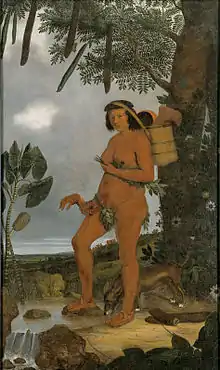Manifesto Antropófago
The Anthropophagic Manifesto (Portuguese: Manifesto Antropófago) was published in 1928 by the Brazilian poet and polemicist Oswald de Andrade, a key figure in the cultural movement of Brazilian Modernism and contributor to the publication Revista de Antropofagia. It was inspired by "Abaporu," a painting by Tarsila do Amaral, modernist artist and wife of Oswald de Andrade.[1] The essay was translated to English in 1991 by Leslie Bary;[2] this is the most widely used version.
| Author | Oswald de Andrade |
|---|---|
| Country | Brazil |
| Language | Portuguese |
Content


Written in poetic prose in the modernist style of Une Saison en Enfer by Rimbaud, the Manifesto Antropófago is more directly political than Oswald's previous manifesto, Manifesto Pau-Brasil, which was created in the interest of propagating a Brazilian poetry for export. The "Manifesto" has often been interpreted as an essay in which the main argument proposes that Brazil's history of "cannibalizing" other cultures is its greatest strength, while playing on the modernists' primitivist interest in cannibalism as an alleged tribal rite. Cannibalism becomes a way for Brazil to assert itself against European post-colonial cultural domination.[5]
One of the Manifesto's iconic lines, written in English in the original, is "Tupi or not Tupi: that is the question." The line is simultaneously a celebration of the Tupi, who practiced certain forms of ritual cannibalism (as detailed in the 16th century writings of André Thévet, Hans Staden, and Jean de Léry), and a metaphorical instance of cannibalism: it eats Shakespeare. On the other hand, some critics argue that Antropofagia as a movement was too heterogeneous for overarching arguments to be extracted from it, and that often it had little to do with a post-colonial cultural politics.[6]
Influences
In the 1960s, introduced to the work of Oswald de Andrade by concrete poet Augusto de Campos, both visual artist Hélio Oiticica and musician Caetano Veloso saw the Manifesto as a major artistic influence on the Tropicália movement. Veloso has stated, "the idea of cultural cannibalism fit us, the tropicalists, like a glove. We were ‘eating’ the Beatles and Jimi Hendrix."[7] On the 1968 album Tropicalia: ou Panis et Circensis, Gilberto Gil and Torquato Neto explicitly refer to the Manifesto in the song "Geléia geral" in the lyric "a alegria é a prova dos nove" (happiness is the proof of nines), which they follow with "e a tristeza é teu porto seguro" (and sadness is your safe harbor).
See also
References
- "Tarsila do Amaral: Inventing Modern Art in Brazil | MoMA". The Museum of Modern Art. Retrieved 2020-08-18.
- Andrade, Oswald de (1991). Translated by Leslie Bary. "Cannibalist Manifesto". Latin American Literary Review. Pittsburgh: Dept. of Modern Languages, Carnegie-Mellon University. 19 (38): 38–47. JSTOR 20119601. Retrieved 2015-07-22.
- Gearini, Victória. "Aventuras na História · Grupo dos Cinco: os precursores do Modernismo no Brasil". Aventuras na História (in Portuguese). Retrieved 2020-08-18.
- "Albert Eckhout, Series of eight figures (article)". Khan Academy. Retrieved 2020-08-18.
- Garcia, Luis Fellipe (2020). "Oswald de Andrade / Anthropophagy". ODIP: The Online Dictionary of Intercultural Philosophy. Thorsten Botz-Bornstein (ed.). Retrieved 13 June 2020.
- Jauregui, Carlos, A. (2012). McKee Irwin & Szurmuk, Robert & Mónica (ed.). Dictionary of Latin American Cultural Studies. Gainesville: University Press of Florida. pp. 22–28.
- Dunn, Christopher, 1964-. Brutality garden : Tropicália and the emergence of a Brazilian counterculture. Chapel Hill, NC. ISBN 978-1-4696-1571-4. OCLC 862077082.CS1 maint: multiple names: authors list (link)
External links
- Text in English, translation by Leslie Bary
- Article in English about Antropofagia by Carlos Jauregui